Amount of energy transfered from one trophic level to next is
1.5%
10%
15%
20%
The correct Answer is:B
Similar Questions
Food chains and the energy flow within an ecosystem provide an important understanding of contingencies and mutual dependencies of organisms. The given below flow chart depicts the energy flow within some members of a grassland ecosystem. The grass in the below ecosystem transducer 120,000 J of sunlight and fixes it into 12,000 J of energy. It is established that 90% of the energy of one trophic level is not passed to the next trophic level. Further assume that the energy transferred from one trophic level to the next is equally shared among the different organisms at that trophic level.
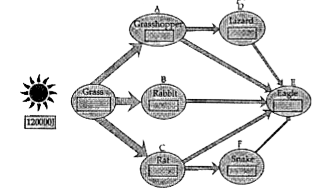
Based on the above information, indicate the amount of energy that an organism C may have received from an organism from the previous trophic level.
View SolutionFood chains and the energy flow within an ecosystem provide an important understanding of contingencies and mutual dependencies of organisms. The given below flow chart depicts the energy flow within some members of a grassland ecosystem. The grass in the below ecosystem transducer 120,000 J of sunlight and fixes it into 12,000 J of energy. It is established that 90% of the energy of one trophic level is not passed to the next trophic level. Further assume that the energy transferred from one trophic level to the next is equally shared among the different organisms at that trophic level.
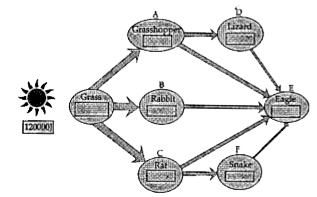
Tropic levels are formed by which of the following components?
View Solution
Knowledge Check
Amount of energy transferred from one trophic level to next is
A90%B10%C50%D1%Energy transferred from one trophic level to another is
A0.05B0.1C0.15D0.2Of the total amount of energy that passes from one trophic level to another, about 10% is
Arespired and becomes heatBpassed on as faeces or urineCstored as body tissueDrecycled to autotrophs
Food chains and the energy flow within an ecosystem provide an important understanding of contingencies and mutual dependencies of organisms. The given below flow chart depicts the energy flow within some members of a grassland ecosystem. The grass in the below ecosystem transducer 120,000 J of sunlight and fixes it into 12,000 J of energy. It is established that 90% of the energy of one trophic level is not passed to the next trophic level. Further assume that the energy transferred from one trophic level to the next is equally shared among the different organisms at that trophic level.
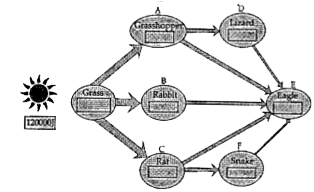
In the food web depicted above, identify the most energy efficient link for tertiary consumer.
View SolutionFood chains and the energy flow within an ecosystem provide an important understanding of contingencies and mutual dependencies of organisms. The given below flow chart depicts the energy flow within some members of a grassland ecosystem. The grass in the below ecosystem transducer 120,000 J of sunlight and fixes it into 12,000 J of energy. It is established that 90% of the energy of one trophic level is not passed to the next trophic level. Further assume that the energy transferred from one trophic level to the next is equally shared among the different organisms at that trophic level.
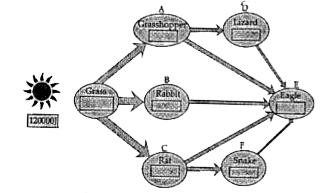
Which organism acts as both the secondary consumer and the tertiary consumer?
View SolutionFood chains and the energy flow within an ecosystem provide an important understanding of contingencies and mutual dependencies of organisms. The given below flow chart depicts the energy flow within some members of a grassland ecosystem. The grass in the below ecosystem transducer 120,000 J of sunlight and fixes it into 12,000 J of energy. It is established that 90% of the energy of one trophic level is not passed to the next trophic level. Further assume that the energy transferred from one trophic level to the next is equally shared among the different organisms at that trophic level.
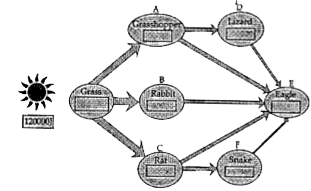
How many food chains are present in the food web depicted above?
View SolutionA food chain depicts the flow of energy from one trophic level to another. Which of the following represents the percentage of energy transfer from one trophic level to the next?
View SolutionThe loss of energy as one proceeds from one trophic level to the next higher level is approximately
View Solution
